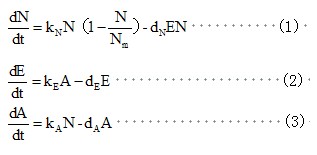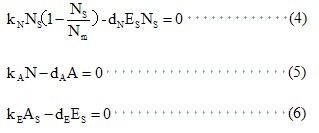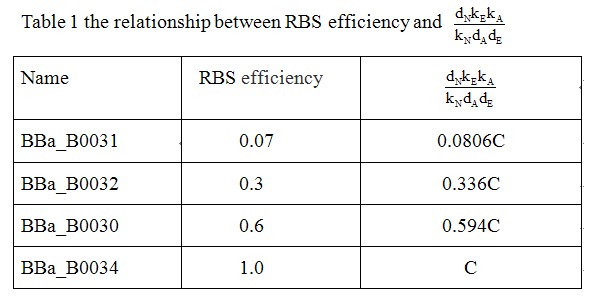Team:XMU-China/Model
From 2011.igem.org
(Difference between revisions)
(→reference) |
|||
| (2 intermediate revisions not shown) | |||
| Line 2: | Line 2: | ||
{{:Team:XMU-China/List}} | {{:Team:XMU-China/List}} | ||
| - | Different RBS sequences | + | Different RBS sequences lead to different levels of expression of the killer protein ccdB which is directly linked to the effects of our programmed cell-death circuit. So we constructed a series of circuits with different RBS sequences so as to detect how RBS of different efficiency can affect the viable cell density at steady state. We build a model to search for a theory to predict growth rule of bacteria with the programmed cell-death circuit. |
| + | |||
We assume that:(1) without the circuit,changes in viable cell density(N,/ml)follow logistic kinetics;(2)for population-circuit growth, the cell death rate is proportional to the intracellular concentration of the kill protein(E, nM) ;(3)the production rate of E is proportional to AHL concentration(A, nM) ; (4)AHL production rate is proportional to N;(5)degradation of the kill protein and AHL follows first-order kinetics. | We assume that:(1) without the circuit,changes in viable cell density(N,/ml)follow logistic kinetics;(2)for population-circuit growth, the cell death rate is proportional to the intracellular concentration of the kill protein(E, nM) ;(3)the production rate of E is proportional to AHL concentration(A, nM) ; (4)AHL production rate is proportional to N;(5)degradation of the kill protein and AHL follows first-order kinetics. | ||
| Line 99: | Line 100: | ||
C is -4.96322E-09 in our experiment. | C is -4.96322E-09 in our experiment. | ||
| + | |||
| + | ==reference== | ||
| + | |||
| + | [1]You L, Cox RS, Weiss R, Arnold FH. Programmed population control by cell-cell communication and regulated killing[J]. Nature, 2004, 428(6985): 868-871. | ||
Latest revision as of 12:07, 28 October 2011
 "
"








